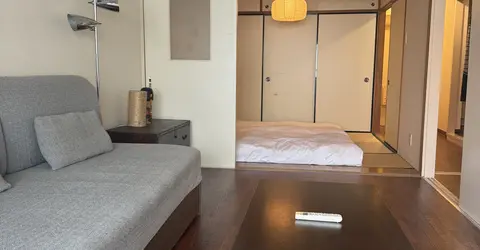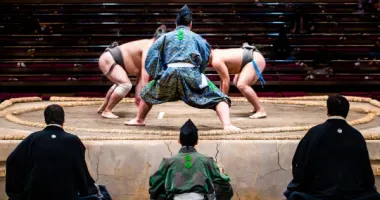Sengakuji Temple 泉岳寺
This Buddhist temple of the Edo era (1603 - 1868) was the scene for one of the most famous samurai stories, 47 Ronin.
Sengakuji Temple - Graves of the 47 Ronin
History
During the Edo era, Sengakuji was one of the three major temples of old Edo (now Tokyo), the other two being Seishoji Temple, just north of Shiba Park, and Sosenji Temple in Tokyo's northern Itabashi ward. Sengakuji is a major temple of the Soto Zen sect of Buddhism, its present site, dates from 1641. It was rebuilt here after the original, founded in 1612 just west of Edo Castle at the behest of Shogun Tokugawa Ieyasu, burned down.
However, Sengakuji Temple's Buddhist credentials are overwhelmed by its fame as the resting place of the 47 Ronin, or 47 Samurai (known as the Ako Roshi in Japanese, Ako being the name of their feudal domain, and roshi meaning much the same as ronin, i.e., masterless samurai.)
It was to here at Sengakuji Temple, where their master Asano Naganori is buried, that the 47 Ronin brought the head of the distinguished courtier, Kira Yoshinaka, on whom they had their revenge. It was also here at Sengakuji Temple that the ronin were buried after also meeting the same fate as their master: death by self-inflicted disembowelment, or seppuku (more commonly known as harakiri in the West).
Sengagkuji Features
Besides its history and easy accessibility from the nearest subway station, Sengakuji Temple has little to commend it. It is small and, apart from its picturesque gate, not especially elegant. Nevertheless, it caters very well to the visitor interested in its past.
Statue of Oishi Kuranosuke
Oishi Kuranosuke (born Oishi Yoshio, 1659-1703) was the chamberlain of Ako domain. The domain was dissolved as part of the punishment meted out to its lord who, while paying his dues at the Shogun's castle, lashed out with his sword at the courtier, Kira Yoshinaka, after being mercilessly taunted by him. Upon the lord's death by decreed seppuku and the dissolution of the domain, Oishi became the leader of the now masterless samurai band that sought revenge on Kira Yoshinaka. Oishi's statue greets the visitor at the gate of the temple. In his right hand is the jointly signed covenant of the 47 ronin, and he glares eastwards, as from Ako domain in the west, to Edo, the source of their troubles in the east.
Akohgishi Kinenkan Museum
The Akohgishi Kinenkan (Ako Masterless Samurai Memorial Hall) is a modern museum on the premises housing realia relating to the exploits of the 47 ronin. There is a video alcove upon entry recounting the tale of the 47 ronin and Sengakuji's place in it (Japanese language only), and the fairly sizable main room has various exhibits of armor worn by the ronin, the drum supposedly beaten to launch the assault on Kira's mansion in Ryogoku, illustrative scrolls depicting the samurai, handwritten documents, and more.
Entry to this newer museum also allows the visitor access to the second floor of the older wing across from it, featuring 47 mannequins of the ronin wearing the actual clothing and (homemade) armor they wore on their mission. Entry is 500 yen.
Graves of the 47 Samurai
At the southern end of the temple, past the Akohgishi Kinenkan, all the way up the stone stairs and on the right, is the cemetery of the 47 Ronin. The graveyard is small, uniform, stark and stony, undecorated except by a smallish, very sombre-looking, standing Buddha figure at one end, and some wooden votive plaques behind almost each of the 47 tombstones. The grave of the leader, Oishi Kuranosuke, alone has been given a small wooden housing. The grave of their master, Asano Naganori, the lord of Ako domain, is next to this plot, but fenced off from the path.
Kubiarai Ido (Headwashing Well)
A meter-or-so high stone column and a plaque mark the spot where the 47 samurai washed the head of the decapitated Kira that they had brought to Sengakuji, before presenting it at the nearby grave of their master.
"Homeless Kodo" Statue
At the left of the main temple building is a bronze statue of Kodo Sawaki (1880-1965), an influential Soto Zen Buddhist teacher, meditating in the lotus position. Kodo was known as "Homeless Kodo" insofar as he broke with tradition in not associating himself with any particular temple.
Suikinkutsu (Water Koto Cave)
Sengakuji has a suikinkutsu (literally "water koto cave"), a type of Japanese garden ornament. It consists of an inverted pot with a hole in the top through which you ladle water. The resulting sound is a tinkling, musical one, reminiscent of the sound of the koto, the traditional Japanese zither.
Sengakuji Gishisai Festival
In early April and on December 14 every year, Sengakuji hosts the Gishisai Festival commemorating the 47 Ronin. This is paralleled by another Gishisai Festival also held on December 14 in Ako, on the border of Hyogo and Okayama prefectures, where the 47 samurai hailed from.
Address, timetable & access
Sengakuji Temple
Address
2-11-1 Takanawa, Minato-ku
108-0074
Japan
Phone
+81 (0)3-3441-5560Access
Sengakuji Temple is accessible from Exit A2 of Sengakuji Subway Station on the Toei Asakusa Line. The way to Exit A2 is clearly signposted in English upon exiting the ticket gates of the station. Go out Exit 2 and veer right. The gate to the temple is across the road at the pedestrian crossing.































